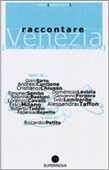 |
Introduction
Raccontare
Venezia - "Tell a Story from Venice" - that is like saying a
city which is loved throughout the world but seldom perceived in its
broader sense. This is what was asked of many writers, some of whom
Venetian, and it led to the selection of thirteen short stories for this
collection. There comes out a heterogeneous, yet contradictory picture and
it reflects the history and tradition of the city.
Besides, stereotypes
for which Venice is universally well-known, play an active role as they
are very much an integral part of this city.
This book can also be seen
as a sort of tourist literary guide with which, in the third millennium,
you can explore the historical lagoon stones without prejudices and see
them in their contemporary essence.
Since we set an age limit of forty
to be eligible for this collection, the thirteen authors can somehow be
defined as "young narrators" if such a definition can be considered valid.
Futhermore, they were advised to use real places in Venice as far as
possible.
I like to remember how the idea for this book first came
about. With the encouragement of Giovanni di Stefano (manager of the
publishing house "Supernova"), the poet Marco Piamonte and I developed it
into its present form in the bookshop "La Ginestra" that he runs near St
Mark's square. Raccontare Venezia is also the
first volume of the series "la ginestralibri".
As the authors and the
editor were often in different places, this project was mainly developed
"virtually," by e-mail, through an ever stimulating dialogue between them.
The focal point of all this activity, was the web site
www.laginestralibri.it, where it is now possible to buy this collection
on-line. Indeed, an entire section of the web site is devoted to
Raccontare Venezia and the reader can actively take part in the
flourishing dialogue.
So let me introduce the stories and their
authors.
What does it feel like to drown in a Venetian canal with your
grotesque and horrendous grandmother, whose only pastime consisted of
finding all possible ways of taking out her anger on her grandson?
Domenico Laviola describes it in Venetian Psycho, a terrifying
account of adolescence in Venice.
Stories of mysterious murders
enliven the conversation of barmen and customers in a pub; headlines of
the local daily paper arouse curiosity and fear. L'Assassino by
Andrea Curcione is a real thriller, and who knows if it is that far from
truth.
In Goodnight Mick by Eric Milano, there are
minimalistic quotations which hark back to some of the American traditions
of the 80s and they are reworked to be deliberately scandalous It is
likely to provoke controversy; however, themes such as drugs and sex in a
Venetian setting, albeit strong, should be interpreted as
provocative.
Is it possible to fall in love with a beautiful girl who
is waitressing at the tables of a bar while you watch a multicoloured
melting pot of people going past two large windows and hope for
inspiration for your travel diary? This is shown by Cristiano Chiusso in
Cafè Noir.
There is a peculiar, solitary, nocturnal and
directionless kind of wandering from bar to bar moving amongst young
students and local customers. This is the scene that Lorenzo Cavalli
describes in L'ultimo rosso.
It could be a dream, a nightmare
or an independent short story; it is me and my Venice - a pocket-sized
island: this is what Sabrina Bastioni claims when describing her
Nocivo.
In the Venetian lagoon, far from prying eyes, there is
the Island of Magic and of the Enchanted World which conceals imaginary
and mythological creatures in its shadows. A difficult love, a myhtological
fairy-tale, at intervals deliberately moralistic: this is what Federica
Repetto proposes in Miti e magie nella Laguna nord.
The short
story Nemesi di un mito by Ivo Lombardo, is presented with
features of a thriller. The discovery of a woman's body in a canal leads
Inspector Berti to make inquires into the intriguing Venetian world of
artists.
Ancora per poco by Gian Sarto opens with glimpes of
past civilazations. The story is a series of terrifying accounts of events
set in Venice which cannot leave the reader indifferent, because of the
strength and the deep-felt sincerity with which they are described.
And
the mainland? Even when it is not explicitly mentioned, the duality which
distinguishes it from Venice clearly emerges. Alessandra Taffon
(Pensieri sull'autobus) highlights the different "commercial"
dimension between the numerous shopping malls to which many Venetians now
flock, and the small local activities which are dying out.
In Tre
giornate Simone Sambo describes the troubled and funny odyssey of a
working student who alternates university life with hours spent at work or
with his girlfriend. The endemic generational confusion of the protagonist
is everpresent.
The ancestral memories and current feelings of a
curious creature which is half mouse half man, characterize the short
chapters of the story Paura by Giovanni Porpora. The unusual
protagonist divides Venice into mental zones where space and time
alternate incessantly.
In Anime by Roberto Taddio, the
narrator relives his "return to Venice" which is full of memories and
atmosphere that have become evanescent over time but conflicting emotions
are still strong.
Finally, I wish to thank the architect Paolo Falcon
who helped us to create the book-cover.
I hope you enjoy this
collection.
Riccardo Petito
|